All emerging writers are familiar with the stress of finding the right literary magazines that pay for short stories. Initial submissions are notoriously difficult to get published.
Even writers who are now considered classics struggled with this issue.
With thousands of literary magazines available to choose from, even just narrowing the selection down can be a tricky task.
We’ve created this list to highlight the best literary magazines to which you can submit short fiction.
- Magazines That Pay for Short Stories (At a Glance)
- An Overview of the Best Magazines That Pay for Short Stories
- The Best Magazine That Pays for Short Stories at a Glance
- Features to Look for in Magazines That Pay for Short Stories
- Best Magazines That Pay for Short Stories: Our Top 3 Options [Ranked & Reviewed]
- Notable Mentions: Other Magazines That Pay for Short Stories to Check Out
- Other Alternatives Relevant to Magazines That Pay for Short Stories
- Frequently Asked Questions
- Wrapping Up
Magazines That Pay for Short Stories (At a Glance)
If you’re in a hurry, here’s a list of our top picks. Scroll further down if you want to learn the details.
- The Threepenny Review: Our Pick
- The Sun Magazine: Runner-Up
- One Story: Also Great
- Strange Horizons: Best for Speculative Fiction/Science Fiction
- The New Yorker: Most Prestigious
- Allegory: High Acceptance Rate
- Ninth Letter: Best for Experimental Submissions
- Apparition Lit: Best for Beginner Horror Writers
- Flash Fiction Online: Best for Flash Fiction
An Overview of the Best Magazines That Pay for Short Stories
According to Edgar Allan Poe’s widely used definition, a short story is a form of fiction that can be read in one sitting.
In terms of numbers, this translates to anywhere under 20,000 words. A typical entry point for most fiction writers is to try and publish short stories.
What Are Magazines That Pay for Short Stories?
A literary magazine is a publication that publishes fiction and creative nonfiction. It focuses on short-form writing: short stories (including flash fiction) and poetry.
While no literary journal will be able to publish every submission, you can get paid for short stories and works that get published.
Why Are Magazines That Pay for Short Stories Important?
Literary magazines are a crucial jumping-off point for all emerging writers.
Wherever your writing ambitions may lie, it isn’t easy to attract any attention from publishers without a portfolio.
In fact, emerging writers sell short stories not only to earn money but also to be known in the industry.
Do I Need to Write to Magazines That Pay for Short Stories?
If you’re interested in earning money through writing, less traditional publishing platforms like Amazon may look like a steadier, more reliable source of income.
Still, it helps your writing career to have published work in traditional literary publications.
The Best Magazine That Pays for Short Stories at a Glance
Before moving on to the rest, consider submitting to one of these two magazines as your preferred option.
What Is the Best Magazine That Pays for Short Stories?
The best literary magazine in the category is The Threepenny Review.
The Threepenny Review is a highly reputable quarterly magazine with the best overall balance of features that writers want from such a publication.
Another factor that makes it stand out is how fast its editors respond to new submissions.
What Is the Best Paying Magazine That Pays for Short Stories?
The magazine with the highest payments for short stories is The Sun Magazine.
The Sun Magazine is a monthly publication that focuses on personal essays. It pays for short stories per written page of text, starting from $200 and going up to $2,000.
Features to Look for in Magazines That Pay for Short Stories
There are several features to consider when choosing a magazine to send short story submissions to.
Most of them can be tracked on Duotrope, a subscription service dedicated to helping writers and artists find agents and publishers.
1. Submission Acceptance Rate
Magazines that pay for submissions will always have much tighter submission criteria and, therefore, lower acceptance rates.
The rates, realistically, tend to go between 5% and close to 0% for unsolicited submissions.
Seek magazines with higher chances of acceptance, but don’t get demoralized by rejection — it’s a simple fact of life for all writers.
2. Payment Rates
Literary journals pay for submissions at a fixed rate for the full finished work, per printed page of text, or per written word. Bigger is always better, but higher pay also means bigger competition, and that means lower acceptance rates.
3. Response Time
Many magazines don’t like when you submit the same work to several publications at once, apart from their own.
This is why a fast response time is critical; it lets you know if you’ve been rejected in enough time to forward your short story to a different address.
4. Literary Niche
Not every literary magazine caters to the same niche.
If your main interest lies in writing science fiction, sending your stories to magazines with a “no science fiction” policy will get you nowhere, no matter how well-written they are.
Always research a magazine’s submission guidelines in detail.
5. Reputability
Getting published in more prestigious, well-known magazines will always be a significant boost to your writing resume.
Reputable magazines also get better funding, which usually translates into higher payments.
Best Magazines That Pay for Short Stories: Our Top 3 Options [Ranked & Reviewed]
We’ve assessed the features of some of the best literary magazines and selected the top three.
1. The Threepenny Review: Our Pick
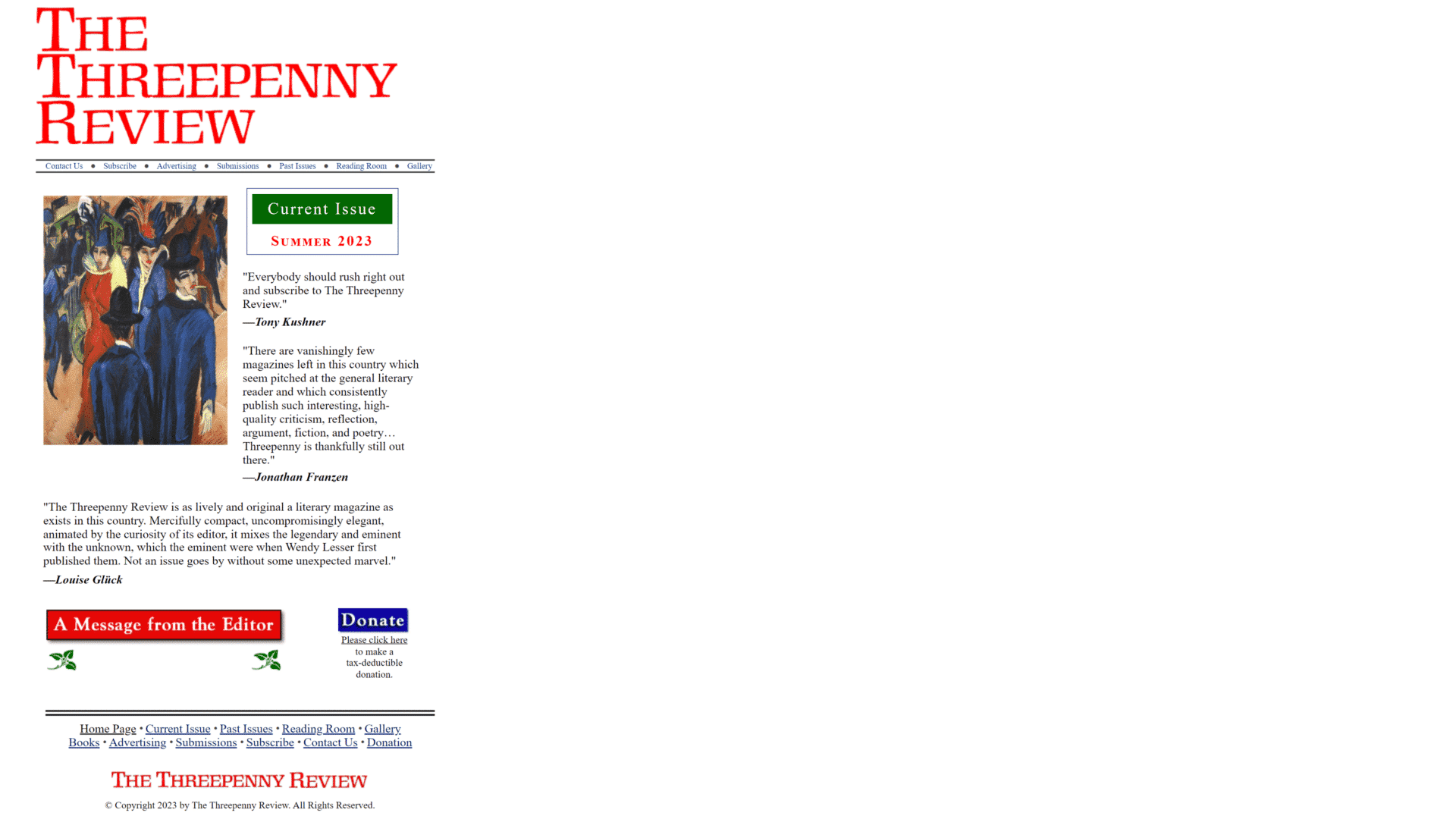
The Threepenny Review is a quarterly magazine that publishes fiction, poetry, and creative nonfiction, with a special focus on cultural criticism.
It’s one of the more highbrow publications on this list, with a long tradition and great reputation in the literary community.
Its submission period extends from January 1 to April 30.
Key Features of the Threepenny Review
- General Thematic Focus: The Threepenny Review doesn’t focus on a specific niche and instead publishes fiction as well as nonfiction of varying genres and with all sorts of themes.
- Short Format: The Threepenny Review’s guidelines prescribe short submissions, with rare exceptions. Short stories shouldn’t go over 4,000 words in length.
- Focus on Print Editions: While the magazine has a website and a paid digital edition in PDF format, the magazine still prioritizes its print publication.
- Prestigious Contributors: The Threepenny Review’s regular contributors include six Nobel Prize winners and four U.S. Poet Laurates.
- The Symposium: A unique hallmark of the journal is its occasional Symposium feature, a series of thematically connected essays structured as a conversation on a particular topic. The themes range from commentaries on current cultural trends to more general topics related to arts and culture.
Pros of the Threepenny Review
- Quick Submission Response: What places The Threepenny Review editorial board above many others is its willingness to respond quickly to new submissions. You may get an acceptance/rejection letter in only two or three days.
- Generous Payments: The Threepenny Review pays $400 per published story or article.
- No Specialization: There’s no thematic or genre focus you need to focus on to get published in The Threepenny Review.
Cons of the Threepenny Review
- Long Nonreading Period: The editors won’t accept any submissions between May 1 and December 31.
- No Simultaneous Submissions: The magazine has a strict policy against sending submissions to more publications at once. Luckily, the quick response time makes up for it.
- Highbrow Profile: The Threepenny Review’s editorial policy focus on high culture may be an issue if your focus is on genre fiction or other, more “lowbrow” forms of writing.
The Threepenny Review Income
- Story or Article: $400 per piece.
- Poem or Table Talk Piece: $200 per piece.
Conclusion: Should You Choose The Threepenny Review?
Although its prestigious reputation and high-profile contributors may make it appear unapproachable, The Threepenny Review has a lot to offer, even to fledgling writers.
The generous pay, openness to fresh faces, and broad thematic criteria should make it one of your first choices when looking for a magazine that publishes fiction.
2. The Sun Magazine: Runner-Up
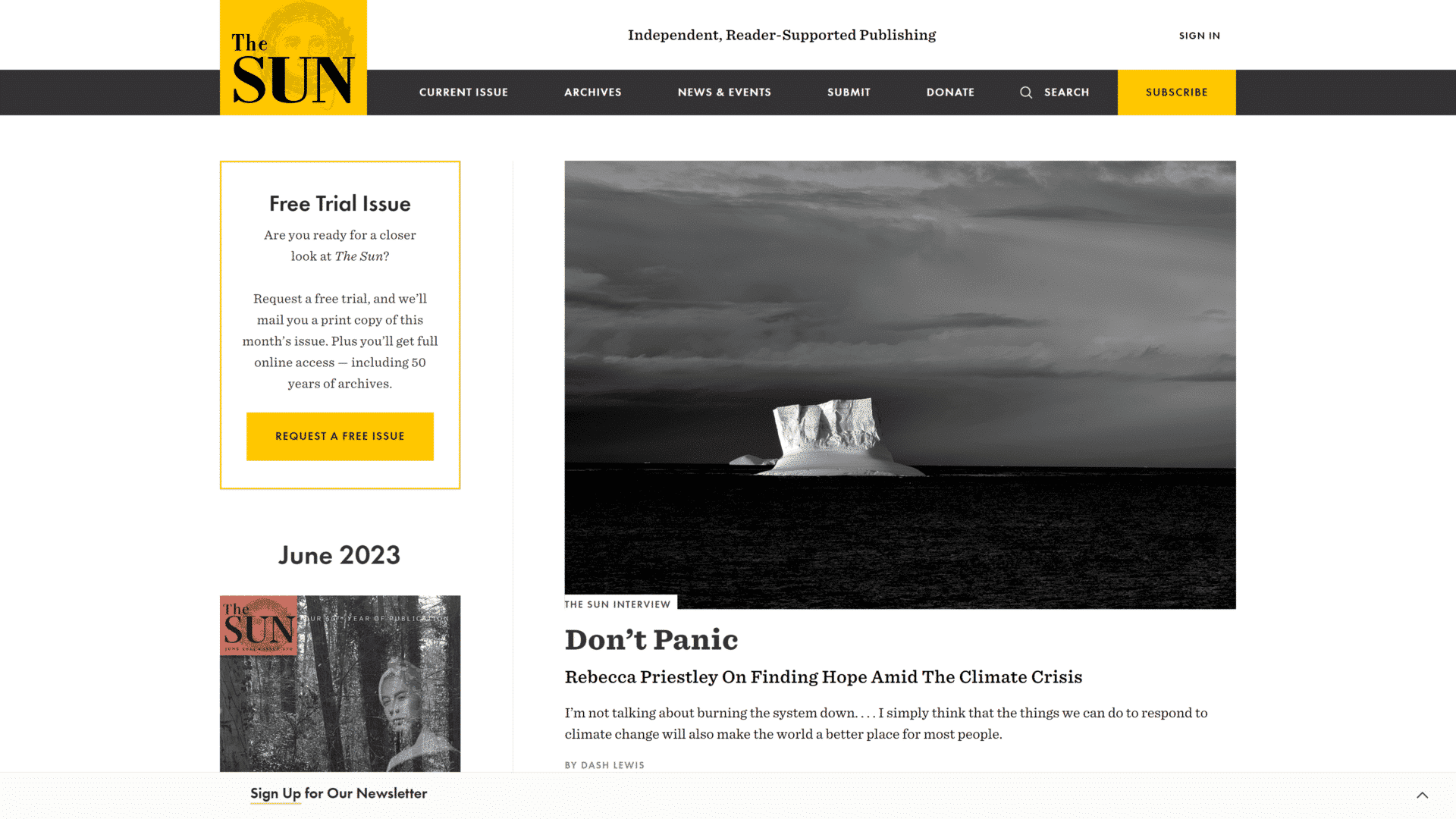
The Sun Magazine is a monthly publication with a full 50 years of tradition. Its mission is to encourage authors to share highly personal, emotionally poignant art.
The submissions may come in the form of personal essays, short fiction, and poetry, but also photography.
Key Features of the Sun Magazine
- Focus on Personal Essays: The editorial policy focuses on creative nonfiction with an autobiographical bent but also publishes fiction written in a similarly intimate tone.
- Welcoming Atmosphere for International Writers: The Sun Magazine provides a space to share various authentic, unique perspectives. This makes it particularly welcoming to international writers compared to most other English-language literary magazines.
- Readers Write: The Sun Magazine has a special section dedicated to reader contributions. These contributions are unpaid but may serve as an excellent springboard for eventually getting properly published.
- Short-Medium Format: Short story submissions can be of any length, but writers are discouraged from going over a 7,000-word limit.
- Flagship Interview: Each issue is headed by a lengthy interview with a relevant thinker from the world of arts, sciences, academics, or politics.
Pros of the Sun Magazine
- Extraordinarily High Payments: While the base pay for short stories is $200, it can go up to $2,000, based on page length. These are among the highest you can get from any literary magazine.
- Monthly Publication Rate: A monthly publication rate means that you can send submissions during the entire year.
- Simultaneous Submissions Allowed: The Sun Magazine allows writers to submit their work to multiple publications alongside their own, as long as they notify the magazine in case the story gets published elsewhere.
Cons of the Sun Magazine
- Narrow Focus on Personal Stories: The magazine nominally publishes fiction of all themes and genres, but its editorial policy favors writers who publish personal essays or auto-fiction.
- Potentially Long Submission Response: The editors may take up to three months to respond to submissions.
- Submissions aren’t free: Submissions can be sent only through a web form that needs you to pay $2.50 to complete.
The Sun Magazine Income
- Personal Essays, Short Fiction, Poetry, and Photo Essays: A minimum of $200 per piece.
- Interior Photos: $200.
- Cover Photos: $500.
Conclusion: Should You Choose The Sun Magazine?
If personal essays are your primary focus, you should consider The Sun Magazine as your first submission choice.
The pay is one of the best in the industry, and the monthly publication rate makes the chance of acceptance relatively decent.
3. One Story: Also Great
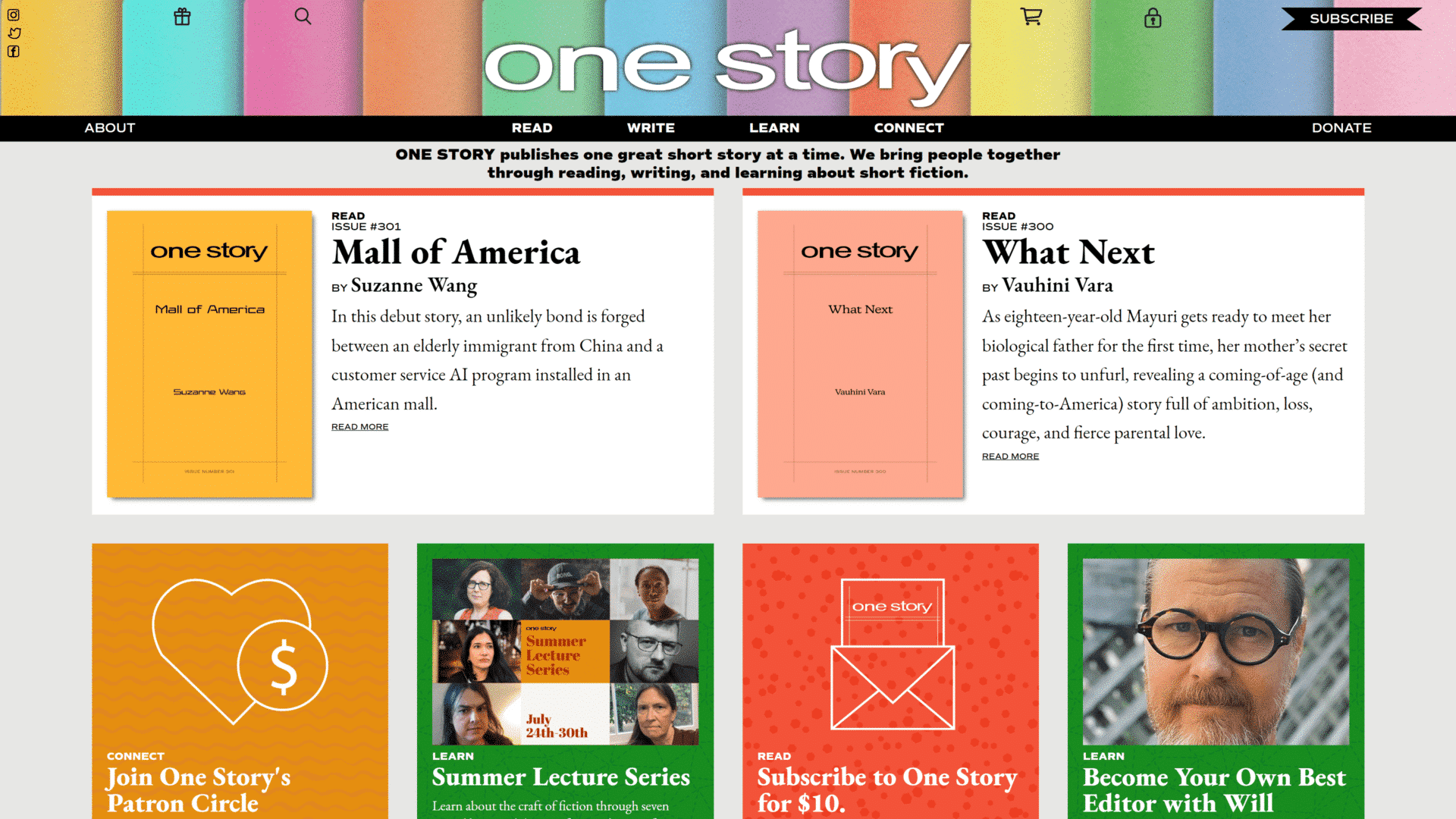
One Story isn’t a literary magazine in the traditional sense. It’s a paid service where, once per month, subscribers receive a single short story that was previously chosen by the editors.
The magazine publishes all genres of contemporary short fiction, chosen from a pool of submissions that are sent every year.
Key Features of One Story
- General Thematic Focus: One Story publishes any genre of short fiction: historical fiction, realistic contemporary fiction, fantasy stories — you name it. The submissions are only expected to fit One Story’s quality standards.
- Youth-Oriented Spin-Off: One Story also publishes a spin-off young adult magazine, One Teen Story. It only accepts submissions from teenagers between 13 and 19.
- Short-Medium Format: One Story automatically rejects any submissions that contain less than 3,000 or more than 8,000 words.
- Digital Issues Available: After publication, short stories can be individually purchased in digital form for $2.50 each.
- Writing Classes: Since its initial publication, One Story has branched out into several side ventures. This includes a set of online writing classes with a special discount for patrons.
Pros of One Story
- Excellent Pay: Published short stories are worth $500 each.
- Simultaneous Submissions Allowed: One Story lets writers submit stories to several publications at once. The only condition is to use the withdrawal form in case the story gets published elsewhere first.
- International Reprints Allowed: One Story allows writers to send work that has already been published outside of North America, as long as the submission is in English.
Cons of One Story
- Low Acceptance Rate: Due to a high number of submissions and the fact that only a single story is published per month, acceptance rates are steadily low.
- Long Submission Response: One Story editors are known for their tardiness—it often takes over three months to get a response. Luckily, this is tempered by an open policy toward simultaneous submissions.
- Submissions Are Web Form Exclusive: Any submissions sent by email will be deleted. Paper submissions are acceptable only in the case of incarceration.
One Story Income
- Short Stories: $500 per piece.
Conclusion: Should You Choose One Story?
Despite the low acceptance rate and a long submission response, a solid earning potential makes One Story a strong contender.
Its thematic versatility makes it a good fit for almost any story you wish to publish. This makes it a clever idea to send submissions to One Story, at least as a backup option.
Notable Mentions: Other Magazines That Pay for Short Stories to Check Out
Although they didn’t make it into the top three, the following magazines are still worth mentioning.
Some of them focus on more specific story niches, while others are solid choices all-around.
4. Strange Horizons: Best for Speculative Fiction/Science Fiction
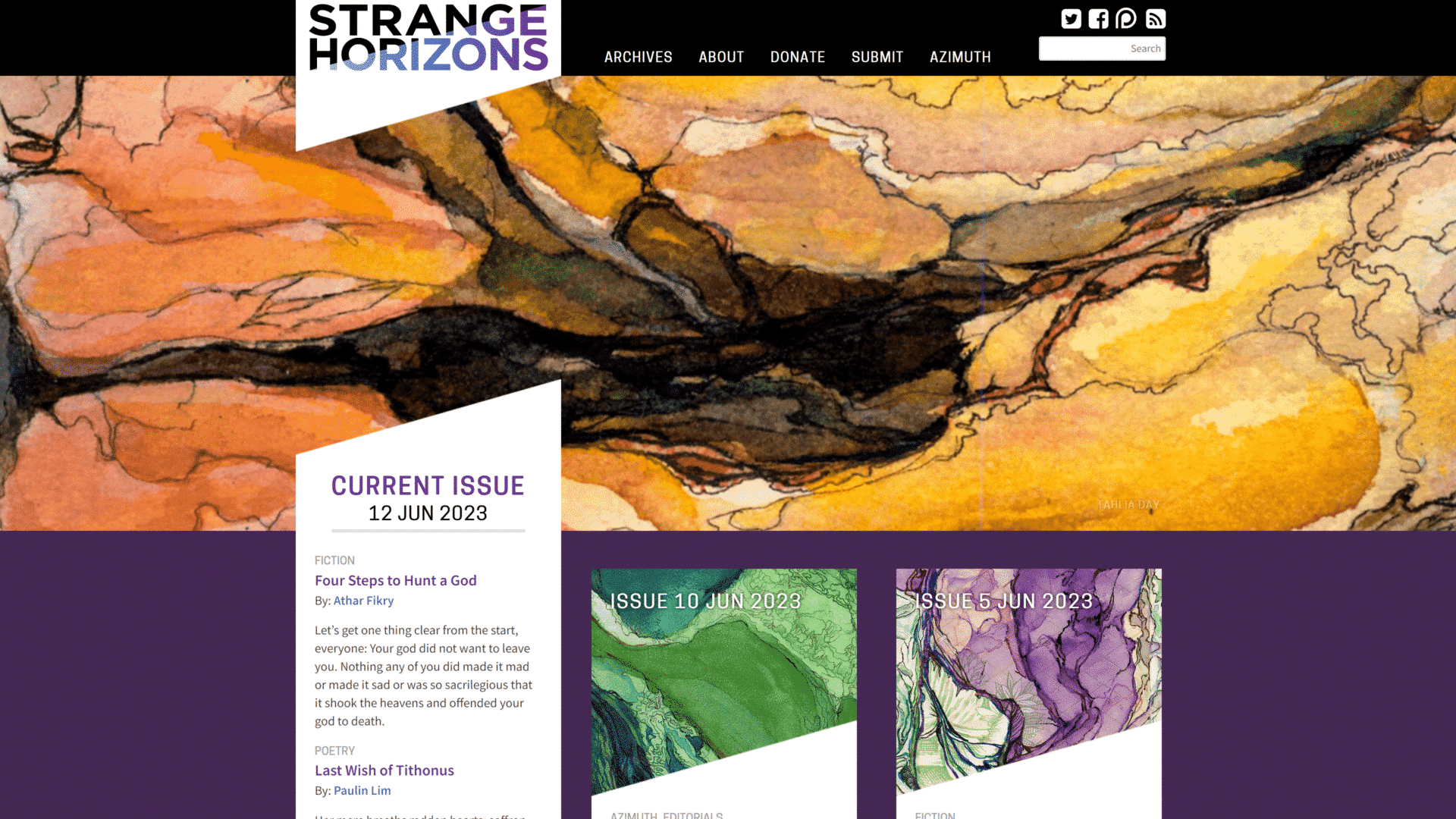
Strange Horizons is an online literary journal that publishes all sorts of speculative fiction every week: fantasy stories, horror, weird fiction, science fiction, and the like.
It’s also known as a reputable platform for poetry, nonfiction, and art on related themes, such as the strange and horrifying aspects of human existence.
The magazine favors short-format submissions, with a preference for stories with less than 5,000 words. The uppermost limit is 10,000 words, though.
Strange Horizons also publishes a spin-off quarterly known as Samovar. It publishes fiction and poetry from international contributors, showcased in dual languages: original and English.
Why is Strange Horizons a Great Option?
As one of the niche’s pioneers, Strange Horizons is among the most prestigious publications in the speculative fiction niche.
Many successful science fiction and horror writers have found Strange Horizons to be an excellent jumping board for their careers.
Three stories originally published in Strange Horizons won the Theodore Sturgeon Award.
The pay rates for submissions are more than solid, with some of the best rates you may find in a magazine focusing on genre fiction.
Due to the weekly publishing schedule, the magazine has a considerably high acceptance rate. But the editors are quick to respond to submissions, never taking more than a few weeks to do so.
Drawbacks to Strange Horizons
For many writers who aren’t interested in science fiction and fantasy, Strange Horizons’ thematic focus may prove constraining.
Due to a high interest in the magazine, submissions are closed for most of the year. The submission policy also bars you from sending simultaneous submissions.
Strange Horizons Income
- Fiction: $0.10 per word.
- Poem Reading: $15 per recording.
- Reprinted Essay: $40 per piece.
- Interview: $45 per participant.
- Poems, Reviews, Columns: $50 per piece.
- Republished Artwork: $100 per piece.
- Original Essay: $150 per piece.
- Original Artwork: $200 per piece.
5. The New Yorker: Most Prestigious

Everyone has heard about The New Yorker. With an unbroken publishing schedule that goes back to 1925, The New Yorker is a weekly magazine focusing on cultural topics.
It’s internationally famous for its literary section, consisting of short stories, poetry, essays, and reviews.
The New Yorker accepts prose submissions between 2,000 and 10,000 words. The website is notably untransparent regarding its submission guidelines; they can be found on the Contacts page.
The magazine is similarly untransparent about its pay rates, too. All information on the topic can be reached only through unofficial sources.
Why is The New Yorker a Great Option?
The New Yorker is easily the most famous and prestigious magazine that publishes fiction submissions in the whole world. No weekly issue goes without at least several notable contributors.
Getting published in the New Yorker is a surefire way to skyrocket one’s literary credentials.
The expected pay rates are jaw-droppingly high. According to word of mouth, getting a short story published in The New Yorker is worth up to $7,500.
Drawbacks to The New Yorker
The most obvious drawback is the magazine’s lack of transparency. Most of the information on pay rates and submission policies can be gained only through second-hand sources.
Getting published in The New Yorker is notoriously tough, too. According to Duotrope, the acceptance rate is as low as 0.14%.
The New Yorker Income
- Short Stories: up to $7,500.
- Poems: $350 for up to 25 lines, $10 for each additional line.
6. Allegory: High Acceptance Rate

Allegory is a biannual online magazine that publishes fiction in the science fiction, fantasy, and horror niches. It’s a non-profit, independent outfit that operates on a purely volunteer basis.
It publishes fiction submissions between 500 and 5,000 words long, with rare exceptions.
The editors are open to submissions outside of the magazine’s niche as long as the stories are original and quirky enough, with a unique twist.
Why is Allegory a Great Option?
As an indie publication that nevertheless holds a degree of authority in the niche, Allegory is a great option for writers looking for a beginner-friendly fantasy/science fiction magazine.
The high acceptance rate helps its case, too.
Drawbacks to Allegory
Indie publications tend to struggle with money, and Allegory is no exception. This means that writers shouldn’t get their hopes up for astronomically high payments. Indeed, Allegory pays a flat rate of only $15 per story.
Story submissions are reviewed in two rounds. The first round is within six weeks of submission.
If a story passes the first review, it’ll be considered for the second round, which is held two months before publication. For writers, this translates to a prolonged period of submission anxiety.
Allegory Income
- Short Stories: $15 per piece.
7. Ninth Letter: Best for Experimental Submissions

Ninth Letter is a literary journal published by the University of Illinois’ Department of English. It takes a particular interest in experimental stories and poems that thread new grounds in terms of form or content.
Ninth Letter’s print and web editions both come out on a biannual basis, but they have separate editors, separate content, and even separate submission guidelines.
The print edition accepts story submissions either as a single piece of literary fiction that’s up to 8,000 words long or up to three separate flash fiction pieces.
The web edition lets you submit fiction stories no longer than 3,500 words related to an issue-specific theme.
Why is Ninth Letter a Great Option?
If you’re feeling adventurous and want to test your writing chops by publishing a more experimental piece of highly imaginative writing, Ninth Letter is the perfect choice.
It may accept submissions that would otherwise be too eccentric for most publications.
Drawbacks to Ninth Letter
The biggest issue with Ninth Letter is its low submission rate, as well as the long average response time.
After sending a submission, it might take the editors as long as four months to send a response.
Ninth Letter Income
- Print Edition: $25 per printed page, up to $150.
- Web Edition: $25 per poem, $75 per story or essay.
8. Apparition Lit: Best for Beginner Horror Writers
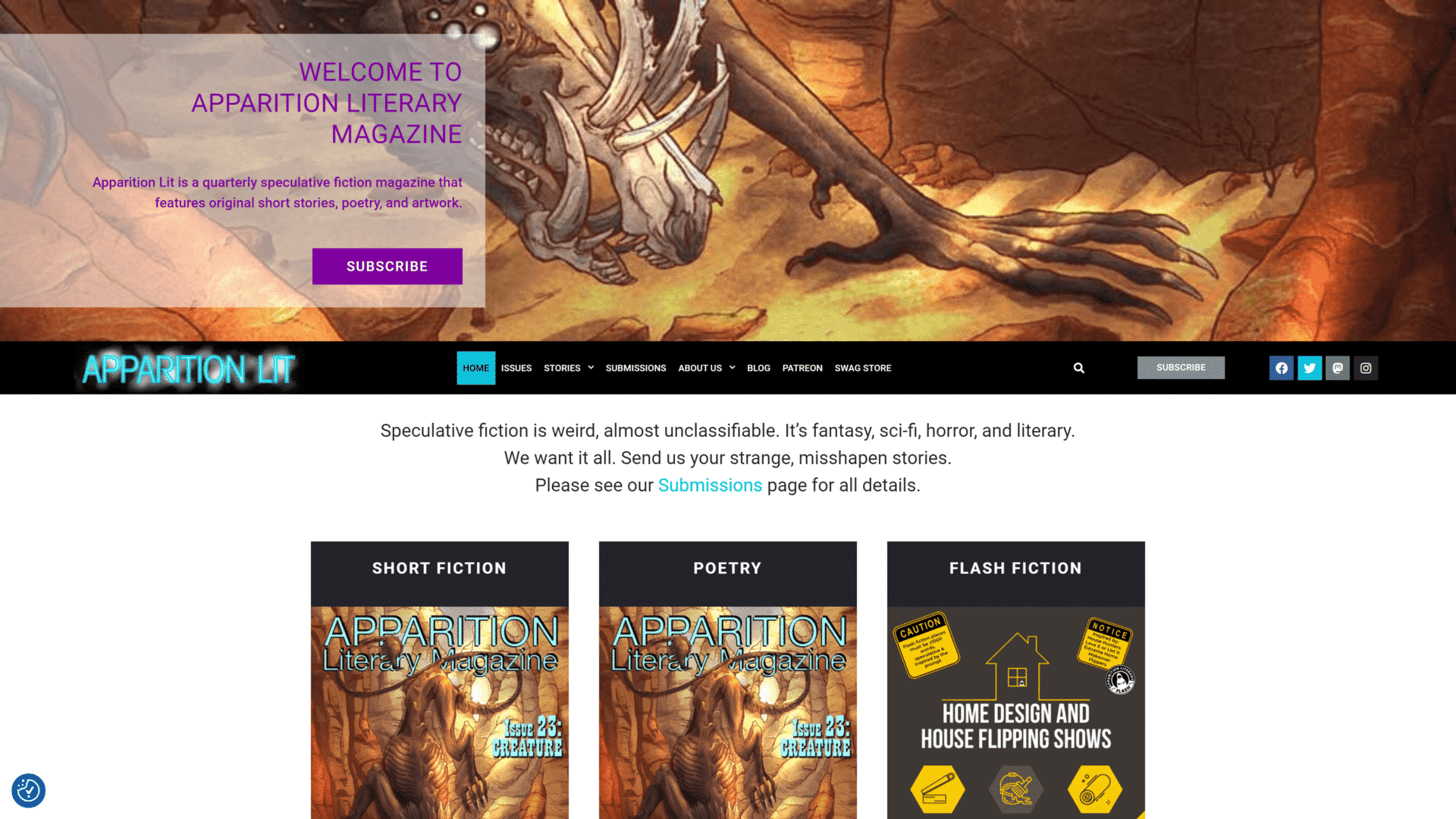
Apparition Lit is a quarterly speculative fiction magazine focusing on dark fiction, horror, science fiction, and fantasy.
The magazine publishes fiction, essays, and poetry and holds monthly flash fiction contests based around a particular theme.
Regular submissions also have to follow an issue-specific prompt since every issue is centered around a particular theme (such as Dread, Nostalgia, or Symmetry).
Story submissions need to range between 1,000 and 5,000 words.
Why is Apparition Lit a Great Option?
Apparition Lit boasts a decently high acceptance rate, which makes it an ideal choice for aspiring speculative fiction writers.
While themed issues may appear constrictive, following a specific theme makes for excellent writing practice.
The magazine has an incredible average response time, with the editors rarely taking more than two weeks to respond.
Drawbacks to Apparition Lit
Themed issues may help with focus and serve as great writing practice, but following themed prompts can prove restrictive in the long run.
This may get especially dire when combined with the sometimes narrow demands of the magazine’s niche.
Apparition Lit Income
- Short Stories: $0.05 per word, with a $50 minimum.
- Poems: $50 per piece.
9. Flash Fiction Online: Best for Flash Fiction

Flash Fiction Online (FFO) is a monthly online magazine that exclusively publishes fiction between 500 and 1,000 words, also known as flash fiction.
It’s open to all genres and themes as long as they manage to fit into the bite-sized, punchy format.
Submissions are open between the 1st and 21st of each month unless the magazine reaches its submission cap of 425 stories.
Why is Flash Fiction Online a Great Option?
Flash Fiction Online allows reprints, which is rare for literary magazines, although under a reduced rate of $0.02 per word.
The regular pay rate of $80 per piece is highly formidable if considering the word count. Flash Fiction Online pays at a rate between $0.08 and $0.16 per word, which is among the better deals on the market.
Drawbacks to Flash Fiction Online
Despite the nonreading period in the last 7-10 days of each month and a submission cap, the editors may leave your submission as a candidate for one of the following issues, raising the expected response time to over two months.
This may be an issue, as FFO doesn’t accept simultaneous submissions.
Flash Fiction Online Income
- Original Submissions: $80 per piece.
- Reprints: $0.02 per word.
Other Alternatives Relevant to Magazines That Pay for Short Stories
Interested in doing creative work for money, but selling your short stories to magazines doesn’t sound particularly attractive? Consider these alternative options.
- Online Writing Sites: There’s a variety of sites where you can offer writing services in exchange for money. Read this article to learn more about them.
- Photography Platforms: Do you feel more passionate about photography? Check this article out to learn about platforms where you can showcase your photography work and earn money doing it.
- Freelance Artist Websites: Do you see yourself as more of a visual type? See this article for a list of websites where you can earn money working as a freelance artist and more useful information about them.
Frequently Asked Questions
How Many Pages Does a Short Story Have?
While a short story can have anywhere up to 20,000 words, how this translates to page numbers depends on the font, format, and spacing. With double spacing, the absolute longest a short story can get is about 80 pages, but most aren’t longer than 30 pages.
How Long Does it Take To Start Making Money from Short Story Submissions?
Everyone who publishes fiction knows there’s never much money to be gained from individual short stories. While you can sell a story for a decent amount, don’t look at this payment as anything other than a morale boost.
To earn serious money, you’ll need to get your first publishing deal.
Wrapping Up
When considering all the features that make a literary magazine good, The Threepenny Review comes out as a definite winner for everyone who wants to publish short fiction.
It provides the ideal balance of quick response time and high payment rates, wrapped in a highly established literary magazine with a general focus.
The other magazines on the list shouldn’t be easily dismissed, though. Each has a specific strong point or particular niche where it excels and should be considered when debating where to submit your latest work.
If you found the article useful, make sure to share it with others who may be interested. And if you’ve got additional literary magazine recommendations, don’t be shy. Tell us in the comment section!







